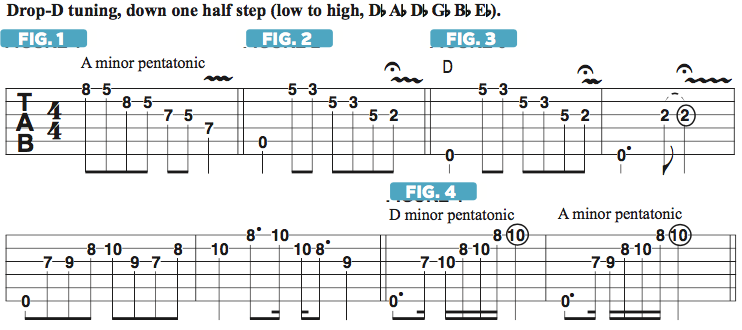Among the first things most electric guitar players learn are the major and minor pentatonic scales. These essential five-note entities are at the root of many styles of modern music, from blues to rock, country, jazz, prog, metal and beyond. The intervallic structure of major pentatonic is 1(root) 2 3 5 6. Minor pentatonic is 1 f3 4 5 f7. In the key of A, A major pentatonic consists of the notes A B C# E F#, while A minor pentatonic is spelled A C D E G. Since these scales are so familiar to many players, a great thing to do is to repurpose all of your favorite pentatonic licks in different musical contexts and key centers. Doing so will allude to different harmony (chords) and modes, and hopefully will help you discover fresh, new sounds.
FIGURE 1 illustrates the A minor pentatonic scale played across one octave in fifth position. As useful as this scale truly is, once you begin to delve into more complex styles of music, such as prog rock, the typical minor pentatonic sound is no longer as intriguing as it may have been earlier in one’s musical development. This led me on a quest to discover as many new scales as I could. What I found was that scales that contain crazy, unusual tensions, or tonal relationships that are uncomfortable to my ear, may be interesting to learn but ultimately not all that conducive to writing new music, because they usually don’t result in anything that is, for me, a genuine output of emotional expression. But there are ways to use pentatonic scales that are outside of the more obvious applications that will generate more rewarding musical sounds.

In FIGURE 2, I play an open A-string pedal tone and then a descending A minor pentatonic scale. A simple twist, as shown in FIGURE 3, is to play the same note pattern over a low-D pedal tone. When you play the notes of A minor pentatonic over a D bass note, the note sequence now referenced is D E G A C, which is the same as D minor pentatonic (D F G A C) but with the second, E, replacing, or “suspending,” the minor third, F. This substitution creates a more harmonically sophisticated and intriguing D7sus2, or D9sus4, sound. FIGURE 4 shows D minor pentatonic played over D, followed by A minor pentatonic over D, and FIGURE 5 offers an improvised melody based on A minor pentatonic over a D pedal tone.
We can also apply this approach to an F tonal center, as shown in FIGURES 6 and 7: the chord played here is Fmaj7, which is built from the notes F A C E; notice that every note except F lives within A minor pentatonic. The most distinctive note in this case is E, the major seventh of F, and if we were to solo using F major pentatonic (F G A C D) or D minor pentatonic (D F G A C), we would be ignoring that really cool chord tone. As shown in FIGURE 7, we can get great musical mileage out of basing an improvisation on A minor pentatonic over an Fmaj7 chord.

All the latest guitar news, interviews, lessons, reviews, deals and more, direct to your inbox!
